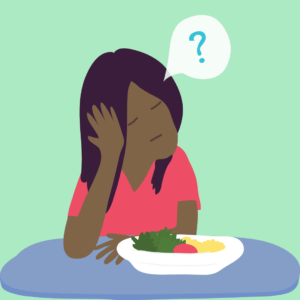If you are struggling with an eating disorder, you are not alone. Restrictive eating disorders are becoming increasingly common. This blog post will provide a comprehensive guide to understanding and treating restrictive eating disorders. We will cover the definition of these disorders, the symptoms, and the best ways to get help. So if you or someone you know is suffering from a restrictive eating disorder, please keep reading.
Contents
What Are Restrictive Eating Disorders?

Res restrictive eating disorders are a type of eating disorder that is characterized by severe limitations in the amount and/or types of food consumed. People with restrictive eating disorders may severely restrict their caloric intake, eat only very small amounts of food, or avoid entire food groups altogether. Anorexia nervosa and bulimia nervosa are the two most common types of restrictive eating disorders, but there are other less well-known forms as well.
People with restrictive eating disorders often have a distorted body image and see themselves as overweight even when they are not. They may be intensely afraid of gaining weight and become preoccupied with thoughts about food, weight, and appearance. As a result, people with restrictive eating disorders often engage in unhealthy weight-control behaviors, such as fasting, excessive exercise, and self-induced vomiting. These behaviors can lead to serious medical complications, including malnutrition, electrolyte imbalances, and cardiac problems.
If you or someone you know is struggling with a restrictive eating disorder, it’s important to seek professional help. Treatment typically involves a combination of individual therapy, group therapy, and medical monitoring. With treatment, most people with restrictive eating disorders can recover and return to healthy eating habits.
What Are the Types of Restrictive Eating Disorders?

Several different types of restrictive eating disorders range in severity:
Anorexia Nervosa
Anorexia Nervosa is the most severe type of restrictive eating disorder. People with anorexia nervosa have an intense fear of gaining weight and will often severely restrict their caloric intake to lose weight. Anorexia nervosa can lead to serious medical complications, including malnutrition, electrolyte imbalances, and cardiac problems. This also increases the risk of suicide.
Bulimia Nervosa
Bulimia nervosa is another severe type of restrictive eating disorder. People with bulimia nervosa often consume large amounts of food and then purge, either through vomiting or by using laxatives. Like anorexia nervosa, bulimia nervosa can also lead to serious medical complications, including electrolyte imbalances and cardiac problems.
Binge Eating Disorder
Binge eating disorder is characterized by episodes of binge eating followed by feelings of shame, guilt, and embarrassment. People with binge eating disorders often eat large quantities of food in a short period and feel out of control during these episodes. While binge eating disorder does not typically involve purging behaviors
Avoidant/restrictive Food Intake Disorder (ARFID)
ARFID is a less well-known type of restrictive eating disorder that was only recently added to the Diagnostic and Statistical Manual of Mental Disorders (DSM-V). People with ARFID avoid certain foods or limit their food intake because they fear choking, vomiting, or gaining weight. ARFID can also lead to malnutrition and other medical complications.
Orthorexia Nervosa
Orthorexia Nervosa is not currently recognized as an official eating disorder but is often described as an obsession with healthy eating. People with orthorexia Nervosa may avoid entire food groups, such as carbohydrates or fats, to eat “healthy”. While orthorexia Nervosa is not considered an eating disorder, it can still lead to unhealthy behaviors and nutritional deficiencies.
Signs of Restrictive Eating Disorders
Sometimes people with restrictive eating disorders may not look like they have an eating disorder. This is because they are often of normal weight or even overweight. However, they may still be restricting their intake of food and nutrients, which can lead to serious health consequences.
People with restrictive eating disorders may:
-have a fear of gaining weight or becoming fat
-have a distorted view of their body weight or shape
-think that they are overweight, even when they are not
-be preoccupied with food and eating
-be obsessed with the calories and fat content of foods
-cook for others but not eat themselves
-eat very small portions of food
-refuse to eat certain foods or food groups
-skip meals
-exercise excessively to burn calories
What Causes Restrictive Eating Disorders?

The causes of restrictive eating disorders are not fully understood. However, research suggests that a combination of genetic and environmental factors may contribute to the development of these disorders.
Family history. People with a family member who has an eating disorder may be more likely to develop one themselves. This suggests that restrictive eating disorders may have a genetic component.
Environmental factors. Certain environmental factors may also play a role in the development of restrictive eating disorders. These include:
- A history of dieting or other disordered eating behaviors
- Exposure to images of thin or “perfect” bodies in the media
- Pressure to be thin from friends, family, or society in general
- Anxiety or depression
- Stressful life events, such as trauma or the death of a loved one
Brain chemistry. Imbalances in certain chemicals in the brain may also contribute to the development of restrictive eating disorders. These include:
- Serotonin. This chemical helps regulate mood, appetite, and sleep. People with low levels of serotonin may be more likely to develop anorexia nervosa.
- Dopamine. This chemical is involved in pleasure and reward signals in the brain. People with anorexia nervosa may have higher than normal levels of dopamine, which could lead them to seek out behaviors that result in weight loss (such as restriction and purging).
How Are Restrictive Eating Disorders Treated?

If you or someone you know is struggling with a restrictive eating disorder, it’s important to seek professional help. Treatment typically involves a combination of individual therapy, group therapy, and medical monitoring. With treatment, most people with restrictive eating disorders can recover and return to healthy eating habits.
Individual therapy
One of the most important aspects of treatment for a restrictive eating disorder is individual therapy. This type of therapy can help you understand the thoughts and emotions that contribute to your disordered eating. It can also provide you with coping and problem-solving skills to deal with difficult situations without resorting to restrictive eating.
Group therapy
Group therapy can be an effective complement to individual therapy. It can provide support and allow you to share your experiences with others who are struggling with similar issues. Group therapy can also help you learn from other’s experiences and gain new perspectives. This type of therapy is typically offered in outpatient treatment programs.
Medical Monitoring
If you have any of these eating disorders, it’s important to see a doctor or other medical professional regularly. This is because restrictive eating can lead to serious health problems, such as malnutrition, dehydration, and electrolyte imbalances. Medical professionals can monitor your physical health and provide you with necessary medical care. They can also offer support and guidance as you work to recover from your eating disorder.
Medications
One of the most common treatments for restrictive eating disorders is the use of medications. Antidepressants, such as selective serotonin reuptake inhibitors (SSRIs), are often prescribed to treat restrictive eating disorders. SSRIs can help reduce the symptoms of depression and anxiety, which can be triggers for disordered eating. Other types of medication may also be used to treat these eating disorders, such as antipsychotics and mood stabilizers.
Nutritional counseling
If you have a restrictive eating disorder, you likely need to receive nutritional counseling. A registered dietitian can help you develop a healthy meal plan and make sure you’re getting the nutrients your body needs. They can also guide how to eat satisfyingly and enjoyably. Nutritional counseling is typically offered in outpatient treatment programs.
Hospitalization
In some cases, people with these eating disorders require hospitalization. This may be necessary if you are severely malnourished or dehydrated, or if you have a medical emergency related to your eating disorder. Hospitalization can also be helpful if you are having difficulty following treatment or if you are at risk of harming yourself.
Conclusion
The prognosis for people with restrictive eating disorders is generally good with treatment. Most people can recover and return to healthy eating habits. However, there is always a risk of relapse, especially during stress. People in recovery need to have a support system in place to help them through difficult times.
If you or someone you know is struggling with a restrictive eating disorder, please seek professional help. Treatment can be very effective but it’s important to get started as soon as possible. Early intervention can make a big difference in the long-term outcome.
This concludes our comprehensive guide to restrictive eating disorders. We hope you found this information helpful. If you have any questions, please feel free to reach out to us. We’re here to help.
Hope this article was of help to you! If you are suffering from eating disorders, you may seek help from Therapy Mantra. We have a team of highly trained and experienced therapists who can provide you with the tools and skills necessary for overcoming eating disorders. Contact us today to schedule an online therapy or download our free Android or iOS app for more information.


